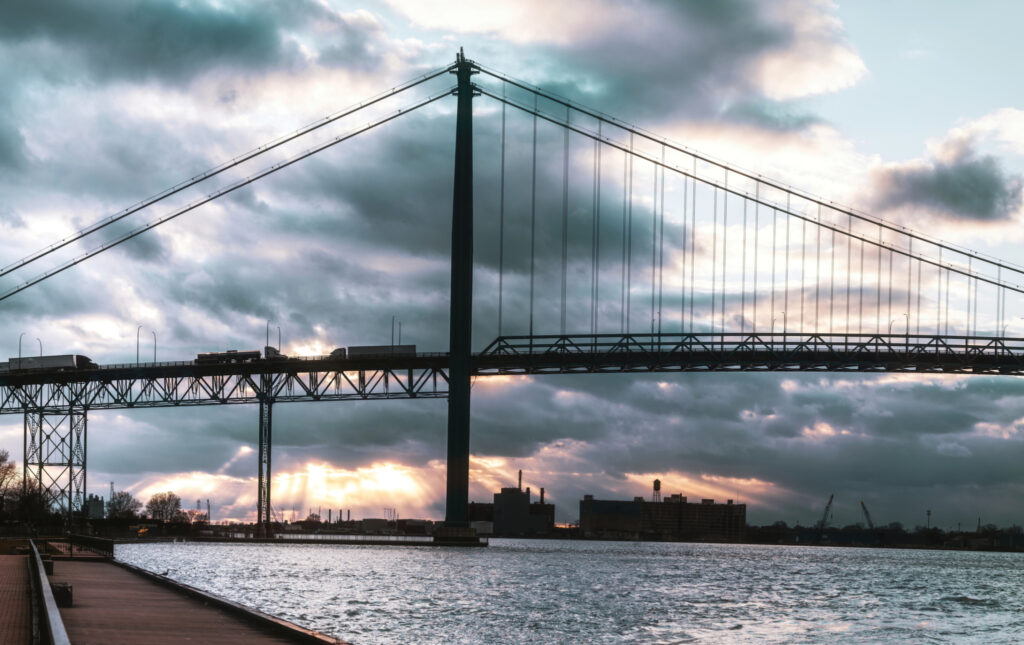Ambassador Bridge owners look to carry more HazMat
The Detroit International Bridge Co., owner of the Ambassador bridge connecting Windsor and Detroit, is proposing to add two classes of hazardous materials that shippers could carry across its four-lane span.
The company, based in Detroit, Mich., has made the proposal to the Michigan Department of Transportation (MDOT). This following the closure last spring of the Detroit-Windsor Truck Ferry, which operated more than two decades before closing due to lack of government funding.

The plea came after a decline in traffic following Covid-19. The ferry handled HazMat and oversize loads. Operator Gregg Ward said anecdotally there were reports some trucks crossed the bridge with HazMat despite the restrictions.
Without an expanded HazMat allowance trucks now must travel 105 miles (168 km) in Canada or 65 miles (104 km) in the U.S. to the Blue Water International Bridge, which is permitted to carry the materials.
The Ambassador Bridge is already permitted to handle several classes of HazMat including gases, flammable solids, oxidizers, and organic peroxides and has done so “for decades without incident,” it says in a release. A bridge official was away for the U.S. Thanksgiving week and could not be reached for comment.
If approved, the bridge would be allowed to have trucks carry Class 3 (fluid petroleum products including gasoline and diesel fuel) and Class 8 (corrosives such as batteries, paints, fertilizers, detergents, textiles, soaps and pharmaceuticals). It would still be prohibited – nor does it seek – to carry Class 1 (explosives), Division 6.2 (infectious substances) and Class 7 (radioactive materials).
Safety upgrades
Meanwhile the new government-owned Gordie Howe International Bridge, scheduled to open in late 2024 and located two miles upstream or south of the Ambassador, will be sanctioned to carry HazMat.
In 2012 MDOT recommended allowing the Ambassador to carry Classes 3 and 8 materials, but never followed through. Asked why, MDOT spokesman Jeff Cranson said only “the leadership at the time made that decision after the process was completed.”
But the bridge company said it went ahead and upgraded its fire suppression system anyway and introduced other safety measures. And it has “filed its petition again.”
MDOT has opened a public comment period on the petition until Dec. 23. Should MDOT approve, the bridge would ensure escort vehicles accompany HazMat transports.
In 2020 the bridge also tried to get the restrictions lifted, the state visited the bridge to inspect. This month it released a study, “to better understand and evaluate the risks.”
The FACTOR study found “a small difference in statewide risk” if the restrictions were lifted but “not significant enough to make a compelling case for or against any changes.” However, it said the “potential consequences” of a Class 3 (fluid petroleum) incident are “greater” than those of a Class 8 (corrosives) incident. MDOT says the proposals “address public safety while seeking to ensure continuity of movement and not limit or delay the transportation of hazardous materials.”
Economic advantages
The bridge also pitches its case from the perspectives of both safety and economic development.
It says the current arrangement means trucks must traverse densely populated metro Detroit to Port Huron-Sarnia. Some 4,200 tankers depart refineries and fuel terminals annually in southwest Detroit and Romulus, a western suburb, and “pass the Ambassador Bridge” enroute to the Blue Water Bridge.
“Considering just these 4,200 truckloads, lifting the restrictions will reduce the number of miles driven by commercial motor vehicles hauling Class 3 materials in Michigan by over 250,000 miles (400,000 km) annually providing a substantial net safety benefit to the State of Michigan,” it says.
And, the bridge says, with the dawn of the electric vehicle (EV) age, allowing the bridge to carry corrosives would be a major benefit for this burgeoning industry. In Windsor, for example, the $5-billion NextStar Energy battery plant – a collaboration between car maker Stellantis and LG Energy Solution – is expected to be in full production by early 2025.
“As electric vehicles become more prevalent, the requirement to efficiently and safely move these critical commodities through the Detroit-Windsor corridor will increase and with the closure of the Detroit-Windsor Ferry, the Ambassador Bridge is in a position to meet those needs,” the bridge owners say.
Bridge management is confident all the safety procedures are in place to handle the new HazMat classes.
“The fire suppression system on the Ambassador Bridge meets all applicable codes, is designed to address incidents arising from all of the foregoing classes of hazardous materials and is regularly inspected by the City of Detroit Fire Department and the City of Windsor Fire and Rescue Services,” it says.
A spokeswoman for the City of Detroit says the city’s mayor, Mike Duggan, “is supportive.” The bridge says the city “engaged in a multi-agency review” and concluded “the plan looks good” including a spill containment system. Detroit police commented that additional traffic would have “no significant impact on the surrounding areas, surface or residential streets.” The trucks would instead seamlessly flow on to I-75.
An official for the City of Windsor could not be reached for comment.
Should the state approve, the Ambassador Bridge says it expects an additional 10,000-20,000 truck crossings. More than 2.3 million trucks now cross the bridge annually.
Have your say
This is a moderated forum. Comments will no longer be published unless they are accompanied by a first and last name and a verifiable email address. (Today's Trucking will not publish or share the email address.) Profane language and content deemed to be libelous, racist, or threatening in nature will not be published under any circumstances.